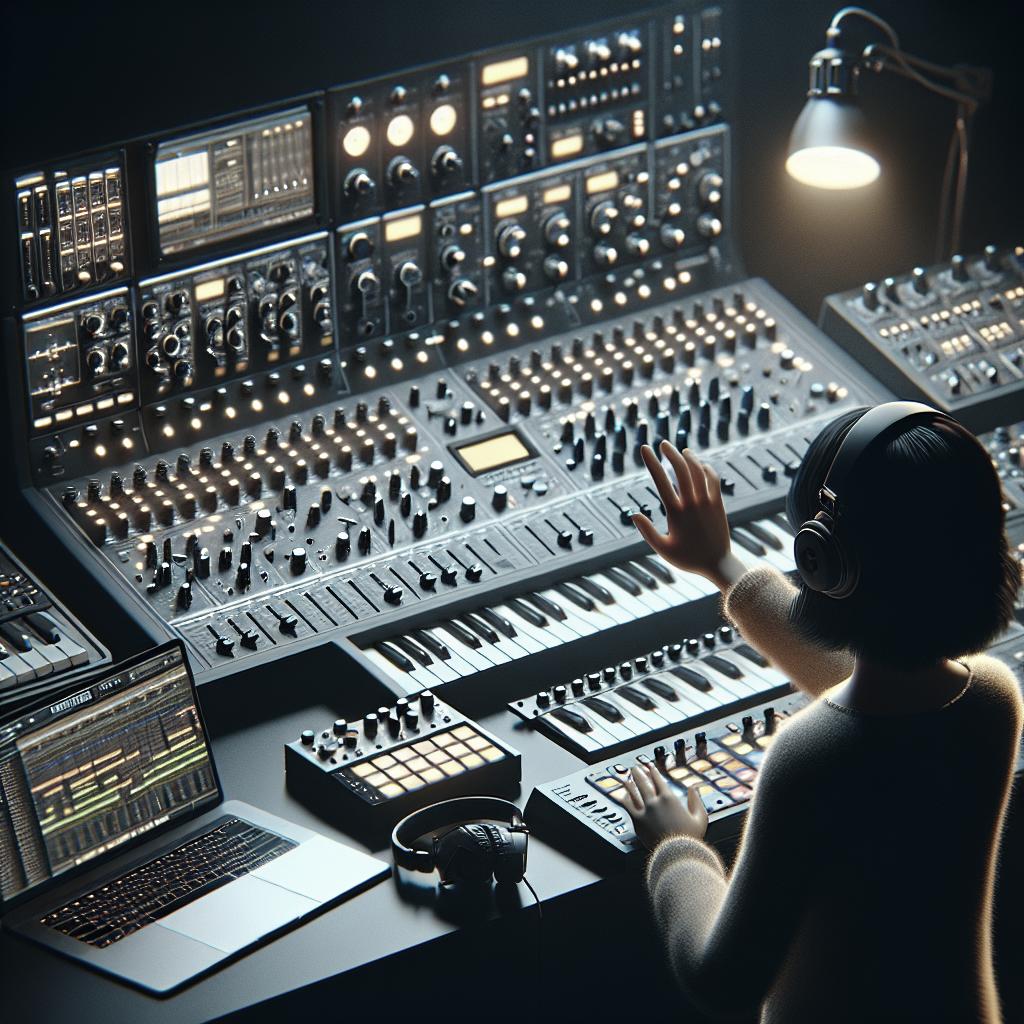<>
Electronic music has carved out a significant niche in the modern music landscape, thanks largely to its dependence on synthesized sounds. Synthesizers play a crucial role in this genre, allowing artists to venture beyond the limitation of traditional instruments. From creating earth-shattering basslines to ethereal pads, synthesizers provide unparalleled versatility. This blog will guide you through the multifaceted world of synthesizers, from basic sound design concepts to advanced techniques. We’ll delve into different types of synthesis like FM, subtractive, and wavetable, discuss the effects and processes that enrich these sounds, and explore their practical applications in music production. Finally, you’ll find useful tips and tricks to enhance your synthesizer skills, making your electronic music productions more compelling and original. —
Getting Started with Synthesizers
Entering the world of synthesizers can be daunting due to the vast array of options and controls. Start by familiarizing yourself with the basic components: oscillators, filters, envelopes, and LFOs (Low-Frequency Oscillators). An oscillator generates the raw sound wave, while filters shape the tonal characteristics of this wave. Envelopes control the amplitude, and LFOs add modulation effects. Choosing your first synthesizer can also be challenging. Consider whether you prefer hardware or software synths. Hardware synths offer hands-on control and are often heralded for their analog warmth. On the other hand, software synthesizers are more versatile and budget-friendly, capable of producing a wide array of sounds.
Sound Design Basics
Sound design forms the foundation of synthesizer use in electronic music. Start by selecting a waveform—sine, square, sawtooth, or triangle—all of which offer distinct sonic characteristics. For instance, sine waves are smooth and pure, while sawtooth waves are richer in harmonics. Next, experiment with the ADSR envelope (Attack, Decay, Sustain, Release), which sculpts the sound over time. By tweaking these parameters, you can produce anything from snappy percussion sounds to smooth, evolving pads. Finally, use filters to manipulate the frequency content of the sound, turning raw waveforms into sophisticated audio textures.
Advanced Sound Design Techniques
Once comfortable with basic sound design, explore more advanced techniques to add depth and complexity. Modulation is key: use LFOs and envelopes to modulate various parameters like pitch, filter cutoff, or amplitude. This can create dynamic, evolving sounds that maintain listener interest. Experiment with layering multiple oscillators and detuning them slightly to create a richer, fuller sound. Additionally, try using white noise or sample-based oscillators to add extra texture and complexity. Don’t forget about ring modulation and frequency shifting, which can produce metallic, bell-like sounds perfect for adding unique character to your tracks.
Frequency Modulation (FM) Synthesis
FM Synthesis, popularized by Yamaha’s iconic DX7, involves modulating the frequency of one waveform with another. This method can produce a vast palette of complex timbres, from bell-like tones to harsh, metallic sounds. Unlike traditional subtractive synthesis, FM synthesis can generate intricate harmonic and inharmonic spectra. To get started, identify your carrier and modulator oscillators. As you increase the modulation index (the depth of modulation), the resulting sound becomes more complex, shifting from simple tones to intricate textures. Experiment with different modulation frequencies and waveforms to discover unique sounds.
Subtractive Synthesis
Subtractive synthesis is one of the most common and user-friendly forms of synthesis. It starts with a rich, harmonically complex waveform, which is then sculpted using filters. By ‘subtracting’ specific frequencies, you can create a wide variety of sounds. Begin by selecting a waveform rich in harmonics, like a sawtooth or square wave. Use the filter (low-pass, high-pass, band-pass, etc.), to shape the tone by removing certain frequencies. Envelope generators and LFOs can further modulate the filter, adding movement and expression to the sound. This method is perfect for creating everything from lush pads to punchy basslines.
Wavetable Synthesis
Wavetable synthesis employs a series of waveforms arranged in a table that you can navigate through in real-time. This form of synthesis allows for dynamic sound evolution and complex timbral changes, making it highly versatile. Begin by selecting or creating a wavetable. Many modern synths allow you to load custom wavetables or use factory presets. Use an LFO or envelope to scan through the wavetable, creating movement and complexity. Effects and filters can further enhance the sound, making wavetable synthesis an excellent choice for modern electronic music production.
Synthesizer Effects and Processing
Effects can transform your synthesized sounds, adding depth, space, and character. Reverb and delay are essential for creating a sense of space and dimension. Experiment with different reverb types (room, hall, plate) to see how they affect the sound. Distortion and saturation can add warmth and grit, making your sounds more aggressive and impactful. Modulation effects like chorus, flanger, and phaser can create movement and width, making your synths sound richer and more dynamic. Remember, effects are tools for creativity—don’t be afraid to experiment to find your unique sound.
Practical Application in Music Production
When incorporating synthesizers into your music production, consider the song’s overall structure and emotional arc. Start by designing the core elements, such as the bassline, lead, and pads, ensuring each part occupies its own frequency space. Pay attention to layering and arrangement. Use complementary sounds to create a full, balanced mix. Automate parameters like filter cutoffs and effects to add variation and maintain listener interest. Synthesizers can be powerful tools for both melodic and rhythmic elements, so don’t hesitate to experiment with unconventional uses.
Programming Synthesizers in DAWs
Digital Audio Workstations (DAWs) make it easier than ever to integrate and program synthesizers. Start with basic MIDI programming, drawing in notes and adjusting velocities to create expressive performances. Most DAWs also offer automation lanes, allowing you to control synth parameters over time. Explore your DAW’s built-in instruments and effects. Many offer powerful synthesizers and extensive preset libraries. Create custom patches and save them for future use, building your unique sonic toolkit. With practice, programming and automation can drastically speed up your workflow and enhance your creative possibilities.
Tips and Tricks for Better Synth Sounds
1. Layer Your Sounds : Combining multiple synth layers can create a richer, more immersive sound. Try detuning layers slightly or panning them to different stereo positions for added width. 2. Use Modulation : Don’t just rely on static sounds—use LFOs, envelopes, and even step sequencers to keep your sounds evolving. Small, subtle modulations can make a big difference. 3. Mind the Mix : Ensure your synthesized sounds blend well with other elements in your track. Use EQ to carve out space and avoid frequency clashes. Sidechain compression can also help synths sit well with kick drums and other rhythmic elements. — ### Future Prospects Here’s a quick reference table summarizing the key points covered:
| Section | Summary |
|---|---|
| Getting Started with Synthesizers | Introduction to basic components and choosing between hardware and software synths. |
| Sound Design Basics | Choosing waveforms and using ADSR envelopes and filters for fundamental sound shaping. |
| Advanced Sound Design Techniques | Exploring modulation, layering, and adding texture. |
| Frequency Modulation (FM) Synthesis | Creating complex timbres using carrier and modulator oscillators. |
| Subtractive Synthesis | Filtering harmonically rich waveforms to create versatile sounds. |
| Wavetable Synthesis | Navigating through waveforms in a table for dynamic sound evolution. |
| Synthesizer Effects and Processing | Using reverb, delay, distortion, and modulation effects to enhance sounds. |
| Practical Application in Music Production | Incorporating synths into song structure and maintaining a balanced mix. |
| Programming Synthesizers in DAWs | Using DAWs for MIDI programming, automation, and creating custom patches. |
| Tips and Tricks for Better Synth Sounds | Layering, modulation, and mix tips for enhanced synth sounds. |


